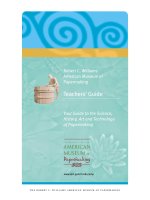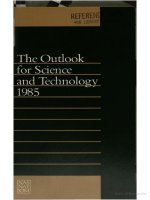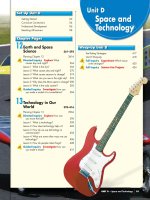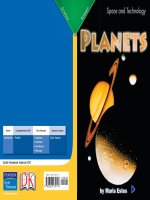3 15 the skys patterns (space and technology)
Bạn đang xem bản rút gọn của tài liệu. Xem và tải ngay bản đầy đủ của tài liệu tại đây (4.11 MB, 14 trang )
Genre
Nonfiction
Comprehension Skill
Sequence
Text Features
•
•
•
•
Captions
Labels
Diagrams
Glossary
Science Content
Day and Night Sky
Scott Foresman Science 3.15
ISBN 0-328-13851-7
ì<(sk$m)=bdifbh< +^-Ä-U-Ä-U
Vocabulary
axis
constellation
lunar eclipse
phase
revolution
rotation
star
telescope
Picture Credits
Every effort has been made to secure permission and provide appropriate credit for photographic material.
The publisher deeply regrets any omission and pledges to correct errors called to its attention in subsequent editions.
Photo locators denoted as follows: Top (T), Center (C), Bottom (B), Left (L), Right (R), Background (Bkgd).
1 Getty Images; 2 Brand X Pictures; 4 Brand X Pictures; 5 Brand X Pictures; 10 (TL) Brand X Pictures, (TR) Brooks
Kraft/Corbis; 11 (TR) Pedro Luz Cunha/Alamy Images; 12 (T, B, CL, CR) Getty Images; 13 Getty Images; 14 (TL, TR) Getty
Images; 15 (TL, TR) Getty Images.
Scott Foresman/Dorling Kindersley would also like to thank: 19 (CA) NASA/DK Images.
Unless otherwise acknowledged, all photographs are the copyright © of Dorling Kindersley, a division of Pearson.
ISBN: 0-328-13851-7
Copyright © Pearson Education, Inc. All Rights Reserved. Printed in the United States of America.
This publication is protected by Copyright, and permission should be obtained from the publisher prior to any
prohibited reproduction, storage in a retrieval system, or transmission in any form by any means, electronic,
mechanical, photocopying, recording, or likewise. For information regarding permission(s), write to
Permissions Department, Scott Foresman, 1900 East Lake Avenue, Glenview, Illinois 60025.
3 4 5 6 7 8 9 10 V010 13 12 11 10 09 08 07 06 05
What did you learn?
1. How do telescopes work?
2. Why can’t we see the new moon?
3. Which star can be used to help
people find their way? Why?
4.
In this
byread
Sasha
Griffi
n
book you have
about
many
patterns. Write to explain how
Earth’s movement around the
Sun creates seasons. Use examples
from the book.
5.
Sequence Shadows are created
when an object blocks sunlight.
Describe how a shadow changes
between morning and evening.
Daily Patterns
Day and Night
During the day there is light. At night it is
dark. This is a pattern that repeats all the time.
The causes of this pattern are the movement of
Earth and sunlight.
Only half of Earth’s round surface faces the
Sun at any one time. The part facing the Sun is lit
by sunlight. The other half of Earth is dark since
it faces away from the Sun.
To us, it looks like the Sun is moving across
the sky. However, it is really Earth that is moving.
The Sun and Earth
The Sun is always in the sky. It is there
during the day, at night, and in all kinds of
weather. The Sun is a star. It is a round,
glowing ball of hot gases. It gives light
and heat to Earth.
Earth is also round like the Sun, but
much smaller. It does not make its own
light. Earth needs light from the Sun.
This photograph of Earth lit by the
Sun was taken by Apollo astronauts
from the surface of the Moon.
2
3
The Sun
Suppose that Earth is a ball of clay, with
a pencil running through its center from the
top to the bottom. Spin the pencil. Then
you can get an idea of how Earth spins
around its axis.
Earth’s axis is an imaginary line that
runs through the planet. It passes through
the North Pole and the South Pole. Earth
spins around its tilted axis. It turns
counterclockwise from west to east.
It takes 24 hours for Earth to make one
complete rotation, or spin around its axis.
As it rotates, half of Earth is lit by the
Sun. It is daytime for that part of Earth.
The half of Earth that is facing away from
the Sun is dark. Every part of Earth has
day and night during this 24-hour rotation.
Earth always rotates at the same speed.
Because of this, the Sun seems to move in
predictable patterns across the sky.
Earth
Day
Axis
Night
The Sun shines on the part of Earth
that faces it, giving daylight.
4
5
Noon
Sunrise
The Sun seems to travel
across the sky. It is at its
highest at noon.
Sunset
Changing Shadows
As the Sun shines, it creates shadows on
Earth. A shadow happens when light, such as
sunlight, shines on an object. The object blocks
the light. Then a shadow appears on the surface
beneath or behind the object. The shadow is the
part of the surface that is not getting light.
Shadows are the same shape as the objects
that stop the light. Unlike the objects, shadows
change length and direction. This is because
shadows depend on where the Sun is in the sky.
6
Early in the morning the Sun appears in the
east. Shadows at this time are long and stretch
away from the Sun, toward the west.
Shadows grow shorter as the Sun seems to
move higher in the sky. By noon, the Sun appears
at its highest. Then shadows are at their shortest.
As the Sun keeps moving toward the west,
shadows become longer once again. But now
they stretch east. This is the opposite direction
from the Sun.
7
Yearly Patterns
Earth’s Movement
While Earth spins on its axis, it also revolves
around the Sun. One complete trip around
the Sun is called a revolution. It takes about
one year, or 365 days, for Earth to make one
revolution.
The four seasons of the year
Spring
During part of its trip around the Sun, the
northern half of Earth tilts toward the Sun.
When this happens, the northern half gets the
most direct rays of sunlight. It is heated the
most. It also has more hours of daylight than
darkness each day.
At other times during Earth’s trip around the
Sun, the southern half of Earth is tilted toward
the Sun. Then this part of Earth gets more direct
sunlight, heat, and hours of light.
Summer
Winter
When the northern
part of Earth is tilted
toward the Sun, it is
summer there.
When the northern
part of Earth is tilted
away from the Sun,
it is winter there.
Fall
8
9
Winter in Boston
Summer in Brasilia
Boston
Brasilia
Making Seasons
Earth’s tilted axis and its movement around the
Sun cause seasons. Temperatures and amounts of
sunlight change in predictable ways throughout
the year.
Boston, Massachusetts, tilts toward the Sun in
June. This is because it’s located on the northern
half of Earth. A city on the southern half, such as
Brasilia, Brazil, tilts away from the Sun.
10
Boston is warmer at that time of year because
it receives more sunlight. There are more hours
of daylight than darkness each day. But in Brasilia
it is colder, there is less sunlight, and there are
more hours of darkness in a day. We say it is
summer in Boston and winter in Brasilia.
As fall grows nearer, Boston receives less
sunlight while Brasilia starts to receive more.
The amounts of daylight and darkness each day
are almost equal in both cities. It is cooler than
summer, but warmer than winter.
When Boston points away from the Sun, it
is winter. Temperatures are colder, and there are
fewer hours of daylight than darkness. When
Brasilia points toward the Sun, it is summer. That
means more sunlight and warmer temperatures.
11
The Moon
The Moon is about 384,000 kilometers
(239,000 miles) away from Earth. That makes it
Earth’s closest neighbor.
Like Earth, the Moon rotates on its axis. The
Moon also revolves around Earth. It takes about
29 days to make one rotation on its axis, and one
revolution around Earth in relation to the Sun.
Path of
the Moon
Earth
The Moon
12
At night, the Moon is the brightest natural
object in the sky. The Moon does not make its
own light. It reflects light from the Sun. We can
see the Moon because sunlight shines on it and
bounces off.
The Moon is always in the sky, and we always
see the same side of it. Sometimes we can see it
during the day. But it is not as bright as it is at
night. This is because the sunlight shining on Earth
is brighter than the light that reflects off the Moon.
13
The Moon’s Phases
After new moon
First quarter
Sometimes the Moon looks like a bright
circle at night. Other times we can’t see it at
all. The look of the Moon follows a changing
pattern. This pattern repeats about every four
weeks. Each different way that the Moon looks
is called a phase.
Half of the Moon is always lighted by the
Sun. But we don’t always see the entire lighted
half. This is because of the way Earth and the
Moon move around each other and the Sun.
14
Full moon
Third quarter
During the phase called the new moon, we
cannot see the Moon at all. This is because the
Moon is between Earth and the Sun. The dark
half of the Moon is facing Earth.
As the Moon continues to revolve, we see a bit
more of it each night. About two weeks after the
new moon, we are able to see all of the lighted
part of the Moon. Now it looks like a circle.
This phase is called the full moon. For the next
two weeks we see less and less of the Moon until
finally it is the new moon again.
15
A Lunar Eclipse
A lunar eclipse happens
when Earth moves between
the Sun and the Moon.
When Earth blocks the Sun’s
light, it makes a shadow on
the Moon. This shadow moves
slowly over the Moon’s surface until it covers it
completely. Then the shadow slowly moves off
the Moon. A lunar eclipse is not a phase of the
Moon and doesn’t happen as often.
Star Patterns
When Earth moves between the Sun and
the Moon, it blocks the Sun’s light.
The Moon will appear
reddish in the part of
Earth that has nighttime.
The Moon is in
Earth’s shadow.
Earth
The Sun
16
The
Moon
Looking at Stars
When you look at the sky on a clear, dark night,
you can see thousands of stars. Some of them are
larger than the Sun. But they look small because
they are so far away. Some stars are dimmer and
harder to see than others. This is because they are
the farthest away. It is difficult for our eyes to see
them. There are many stars that cannot be seen at
all without special tools.
17
Galileo and the Telescope
A telescope is a tool that makes faraway
objects appear closer and easier to see. There are
different kinds of telescopes. Most try to allow
as much light as possible into the telescope. They
are made with mirrors that reflect light and lenses
that bend light. These telescopes make objects
appear bigger or brighter.
Galileo was a scientist who lived in Italy from
1564 to1642. He did not invent the telescope, but
he is known for making one that could magnify
objects by twenty times. With his telescope,
Galileo discovered many new
things in space. At that
time, most people thought
that the Sun revolved
around Earth. Galileo’s
experiments and
observations helped
show that Earth
revolves around
the Sun.
Galileo made important
discoveries about space.
18
The Hubble Space
Telescope floats in space.
The Hubble Space Telescope
While most telescopes are meant to be used
on Earth, the Hubble Space Telescope was built
for use in space. It is about 600 kilometers
(375 miles) above Earth. It revolves around Earth
every ninety-seven minutes. Scientists receive
pictures and information about space from the
Hubble telescope. This has taught them lots about
faraway stars and planets in our solar system.
19
Constellations
Cancer
Scorpius
Ursa
Major
Long ago, people noticed that groups of stars
made patterns in the sky. These patterns often
looked like animals, people, or other things. They
gave names to these patterns and made up stories
about them. A group of stars that makes a pattern
is called a constellation. Today we still use many
of the constellation names that people created
in ancient times. Different groups of people had
different names and stories for the constellations.
Many of the names and stories came from legends.
20
Leo
One constellation is Ursa Major, which means
Great Bear. We can see the Big Dipper in the
body and tail of the bear. The story the ancient
Greeks told about this constellation was that an
angry god turned a woman into a bear. Other
cultures told of a girl who turned herself into
a bear. Then she chased her sister and brothers.
To escape her, they all flew into the sky, where
they became the constellation of the Great Bear.
21
North Star
The stars in a constellation may look close
together. But they are really very far apart.
Because of this, they would not make the same
pattern if you looked at them from space.
Earth’s movement changes the patterns
of stars. As Earth rotates on its axis, the
stars appear to move across the sky. The
constellations also change position as the
seasons change. The constellations in the winter
sky are different from those in the summer sky.
Only the North Star does not appear to move.
This is why people have used the North Star for
hundreds of years to help them find their way.
Spring
Summer
Fall
Winter
The sky has lots of patterns. Earth and the
Moon are always following patterns as they move.
Earth’s movements make it change from day to
night and from season to season. We can learn a
lot by studying these patterns and other objects in
the sky, such as the Sun and stars. Year after year,
Earth continues to follow some amazing patterns.
The stars of the Big Dipper help
people find the North Star.
22
23
Vocabulary
Glossary
axis
constellation
axis
lunar eclipse
phase
revolution
constellation
rotation
star
lunar
eclipse
telescope
2. Why can’t we see the new moon?
a group of stars that make a
pattern
3. Which star can be used to help
people find their way? Why?
when Earth blocks the Sun’s light
from shining on the Moon
4.
In this
book you have read about many
patterns. Write to explain how
Earth’s movement around the
Sun creates seasons. Use examples
from the book.
5.
Sequence Shadows are created
when an object blocks sunlight.
Describe how a shadow changes
between morning and evening.
the different ways the Moon looks
revolution
the movement of an object, such
as Earth, in one complete circle
around another object, such as
the Sun
rotation
one complete turn around an axis
star
a large ball of glowing gases that
gives off light
Picture Credits
Every effort has been made to secure permission and provide appropriate credit for photographic material.
The publisher deeply regrets any omission and pledges to correct errors called to its attention in subsequent editions.
Photo locators denoted as follows: Top (T), Center (C), Bottom (B), Left (L), Right (R), Background (Bkgd).
1 Getty Images; 2 Brand X Pictures; 4 Brand X Pictures; 5 Brand X Pictures; 10 (TL) Brand X Pictures, (TR) Brooks
Kraft/Corbis; 11 (TR) Pedro Luz Cunha/Alamy Images; 12 (T, B, CL, CR) Getty Images; 13 Getty Images; 14 (TL, TR) Getty
Images; 15 (TL, TR) Getty Images.
a tool that magnifies objects that
are far away
Scott Foresman/Dorling Kindersley would also like to thank: 19 (CA) NASA/DK Images.
Unless otherwise acknowledged, all photographs are the copyright © of Dorling Kindersley, a division of Pearson.
ISBN: 0-328-13851-7
Copyright © Pearson Education, Inc. All Rights Reserved. Printed in the United States of America.
This publication is protected by Copyright, and permission should be obtained from the publisher prior to any
prohibited reproduction, storage in a retrieval system, or transmission in any form by any means, electronic,
mechanical, photocopying, recording, or likewise. For information regarding permission(s), write to
Permissions Department, Scott Foresman, 1900 East Lake Avenue, Glenview, Illinois 60025.
24
1. How do telescopes work?
an imaginary line around which
Earth spins
phase
telescope
What did you learn?
3 4 5 6 7 8 9 10 V010 13 12 11 10 09 08 07 06 05









